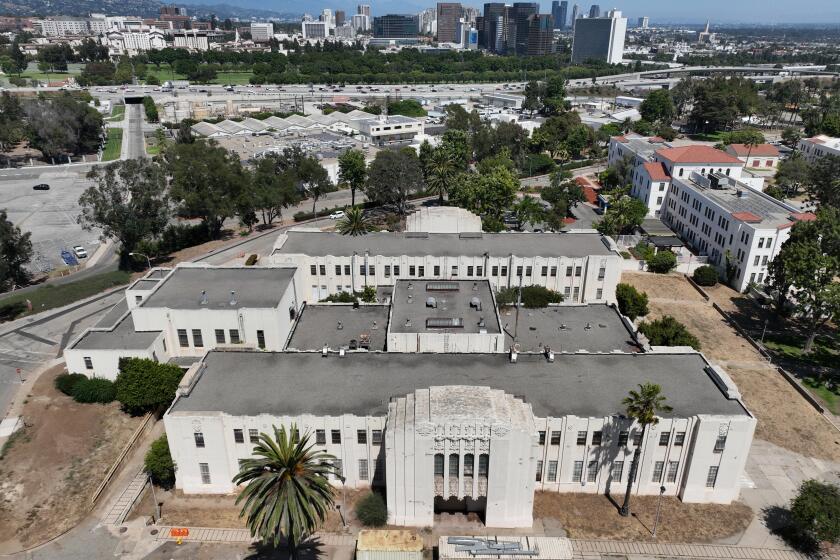MTA Strike Interrupts Health Care
For the full month that the mechanics strike has idled most of Los Angeles County’s buses, 8-year-old Gerardo Garcia has been sick.
He has a bronchial infection that is so bad his doctors are afraid the passages in his lungs will swell and prevent him from breathing. He has an ear infection that has gone untreated for so long that he could lose his hearing.
Without public transportation, his mother had no way of getting Gerardo to a doctor. He made it, finally, to the offices of Dr. Pedram Salimpour on Tuesday, after his mother, Martha Garcia, found a ride.
“He started coughing, and then the strike came,” she said.
Throughout the county, in the free clinics and the practices specializing in Medi-Cal where the poorest residents are treated, doctors and patients are telling stories like Gerardo’s. Among them: the 78-year-old-man who suffered for three days with a dislocated finger before walking 17 blocks to White Memorial Medical Center in Boyle Heights and the diabetic who ran out of insulin and got a ride to a South Los Angeles clinic with overwhelming levels of sugar and acid in her blood.
At the 40 community clinics that provide care to many of the 2 million uninsured people in Los Angeles County, cancellations of routine medical appointments are as much as three or four times higher than typical rates, according to clinic directors. Similar no-show levels are reported at some county hospitals and clinics, as well as at private medical offices that serve the poor and working poor.
“It’s a fiasco,” said Salimpour, whose Sherman Oaks practice is several miles from the Garcia family’s home in Panorama City.
The trains and buses that serve 400,000 Los Angeles County residents a day stopped running Oct. 14, when the mechanics who maintain the vehicles for the Metropolitan Transportation Authority walked off the job in a dispute over wages and health insurance. They were supported by unions representing drivers, dispatchers and clerks.
MTA board Chairman Zev Yaroslavsky and mechanics union President Neil Silver have worried about the effect of the strike on patients’ access to health care -- and each has blamed the other.
“If somebody is getting sick because he can’t get to the doctor, it’s because of him,” said Yaroslavsky, who believes that Silver called the strike in part to improve his position in an upcoming union election.
Pointing to a union offer -- spurned by the MTA -- to go back to work if the dispute were submitted to binding arbitration, Silver said, “It’s not our fault. We offered to go back to work.”
As the strike drags on, doctors and hospital administrators are scrambling to help patients as best they can. Most will see patients whenever they can get in, even though that can mean long waits and significant juggling of loads for labs and physicians.
Several hospitals are running shuttles to help employees get to work, and White Memorial has maxed out a program that offers patients van rides to the doctor.
Doctors at Kaiser Permanente’s hospital on Sunset Boulevard in Hollywood gave a woman and her 11-year-old daughter a voucher for a taxi ride home after the girl underwent surgery on her arm. The two had walked two hours to get to the hospital for the operation, said a Kaiser spokeswoman, Pamela Dean.
Most medical offices and clinics have few such resources.
Yasser Aman, director of the University Muslim Medical Assn. Free Clinic in South Los Angeles, said that, in cases of extreme need, he passes out a small number of taxi vouchers that have been donated for use in emergencies.
Salimpour is trying to negotiate with taxi companies for discounted fares for his patients, and is referring them to social service organizations that provide rides and access to other services.
Many of his patients -- including the Garcias -- come from families that own cars. But the vehicles are needed to transport parents to work.
Sylvia Drew Ivie, executive director of T.H.E. Clinic in South Los Angeles, used her own car to drive expectant mother Shawn Garbutt to a hospital on Tuesday.
Garbutt, two children in tow and two weeks overdue with her third child, went to Ivie’s clinic without an appointment because she thought the baby had stopped moving. She got a ride for part of the way and walked another 20 minutes, arriving at the clinic well into the medical condition that precedes labor.
“I had an appointment to come in every week,” Garbutt said. “I was worried about the baby, but the only way I can get to the doctor is by the Metro.”
At particular risk from missed appointments are children with asthma and related breathing problems, as well as people with chronic conditions such as diabetes, said Jim Mangia, chief executive officer of St. John’s Well Child and Family Center, which cares for 40,000 people annually at six clinics in Los Angeles.
Since the strike started, patient loads have dropped by 200 people per week at the organization’s clinic near Exposition Park, Mangia said.
“We’re seeing patients who have chronic diseases who are not coming in for their regular checkups and regular labs,” he said.
“And so they’re coming in with really elevated glucose levels or really high cholesterol levels.... They’re feeling dizzy, they’re getting infections.... We’re really alarmed.”
To make matters worse, Mangia said, the no-shows are costing the clinic about $15,000 a week in fees that Medi-Cal or another funding organization would have paid, had those who canceled their appointments shown up.
Mandy Johnson, chief executive officer of the Community Clinic Assn. of Los Angeles County, said clinics are suffering financially because 30% to 40% of those scheduled to see doctors or nurse-practitioners are canceling. The clinics are hurting, she said, because they must pay staff members whether or not patients show up.
“These clinics operate on a very slim margin,” Johnson said. “The strike has been on a month and, if it continues, I think we’ll see clinics cut back on their staffing.”
There also has been an effect on emergency-room care.
Officials at both Kaiser Permanente and Olive View Medical Center, a county hospital in Sylmar, report drops in the number of people going to their emergency rooms during the strike, prompting speculation that even the very ill are having a hard time seeking care.
“In our emergency room we are seeing 200 less people each week since the strike started,” said Dean, the Kaiser spokeswoman. “We attribute that to the strike.”
At the same time, some of those who do show up in emergency rooms might have been able to avoid emergency care if they had been able to visit their doctors regularly.
“We have had patients who said they couldn’t get to a doctor’s appointment and couldn’t get to a pharmacy,” said Dr. Brian Johnston, an emergency-room physician at White Memorial and former president of the Los Angeles County Medical Assn.
“We had one case of a 78-year-old guy -- he lives 17 blocks away and had no way to get here except walking,” Johnston added. “He waited three days with a dislocated finger to come in.”
The situation is particularly hard for the uninsured who get care at free clinics, because they rely on the facilities for prescription drugs as well as visits to a physician, said Dr. David Martin, medical director of T.H.E. Clinic.
Esperanza Ramirez has less than a week to go on her medications, and she’s trying hard not to run out. Ordinarily, the 75-year-old takes two buses from her home in Compton to the University Muslim Medical Assn. clinic on Florence Avenue in Los Angeles, where she goes for free treatment and prescription drugs.
But she canceled the appointment scheduled for earlier this week and couldn’t get another until December. Administrators told her, though, that she could go in without an appointment if her medicines ran out.
So, Ramirez hopes the buses start running again by Tuesday, when she’ll need them. She has thought about taking a taxi, but the last time she did that it cost $36 -- much more than she could afford.
“This is very bad,” she said. “There are thousands and thousands of us who depend on those buses. All of this is happening because of the strike.”
More to Read
Sign up for Essential California
The most important California stories and recommendations in your inbox every morning.
You may occasionally receive promotional content from the Los Angeles Times.










